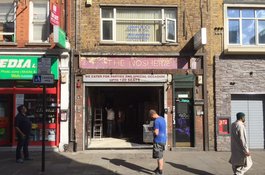22 Osborn Street
1955-7 workshops, now offices with restaurant. This was the site of a courthouse from the 1790s to 1850s and a cinema from 1908.
22 Osborn Street
Contributed by Survey of London on March 30, 2017
Osborn Street's east side had a new frontage formed by road widening in the 1780s. It was only slowly built up. A courthouse flanked by tall sugarhouses took up places at its centre in the 1790s. The Court of Requests for the Tower Hamlets was a small claims court established in 1750 to succeed Stepney’s manorial Court of Record in the north-east of Whitechapel parish in dealing with debts under 40_s._ Its courthouse on Osborn Street (on the site of Nos 22–24), built in 1790–2 following enabling Acts, was said by J. P. Malcolm to have been ‘handsome’ and appears to have had a pedimented façade. Samuel Hawkins, the treasurer, and perhaps also the builder–architect, laid the foundation stone. The County Court Act of 1846 abolished courts of requests, but these premises continued to be used for Whitechapel County Court until 1859. From 1908 there was a cinema on the site of No. 22. There was redevelopment after war damage in 1955–7 for light industrial use. The building now accommodates offices over an Asian restaurant.1
-
The World, 3 June 1790, p.3: Morning Chronicle, 11 Dec 1792, p.2: James Peller Malcolm, Londinium Redivivum: Or an Ancient History and Modern Description of London, vol.4, 1807, p.454: Hubert Llewellyn Smith, The History of East London, 1939, p.69: Richard Horwood's map, 1813: Ordnance Survey map, 1873: Post Office Directories: Tower Hamlets planning applications online: Historic England Archives, aerial photographs, EPW005770, EPW055309 ↩

Works to shopfront
Contributed by Shahed Saleem